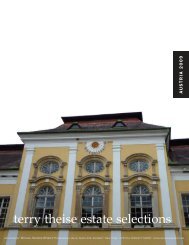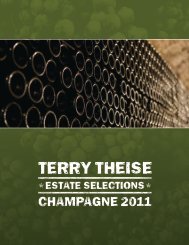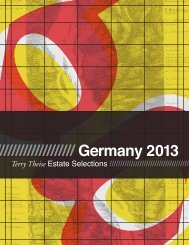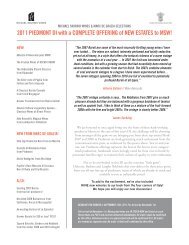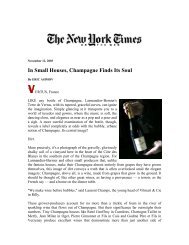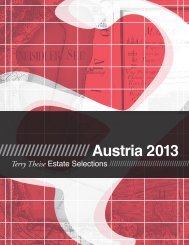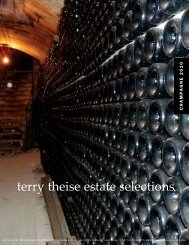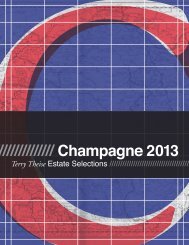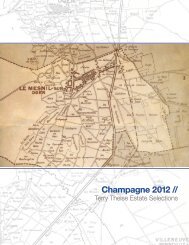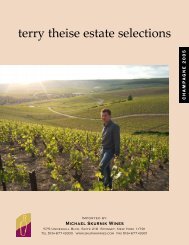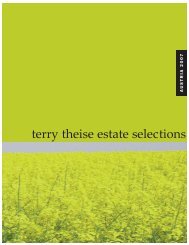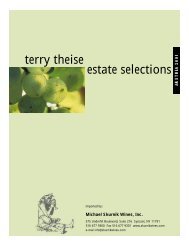German Catalog 2006 USE THIS ONE.qxp - Michael Skurnik Wines
German Catalog 2006 USE THIS ONE.qxp - Michael Skurnik Wines
German Catalog 2006 USE THIS ONE.qxp - Michael Skurnik Wines
Create successful ePaper yourself
Turn your PDF publications into a flip-book with our unique Google optimized e-Paper software.
PFALZ WINES<br />
164<br />
eugen müller<br />
pfalz • forst<br />
In 20+ years of making my rounds in March, I never saw more than a dusting of snow, and<br />
even that was rare. The day we excursed to the Pfalz from Nierstein the forecast was for snowchanging-to-rain<br />
but it never did. In the three hours we sat tasting at Müller I think 6 inches of<br />
heavy wet snow fell. And the road-crews were on strike! Getting home was interesting that<br />
night. Good thing we had bellies-full of Bach-Mayer’s fabulous schnitzels to reassure us.<br />
Müller’s was the first visit in the Pfalz, and thus the first vintage-tales we heard. It was Stephan<br />
Müller who told us of bunch-thinning by cutting the center-berries away “These are the ones most<br />
vulnerable to rot,” he explained., “and it also increases air-flow to the remaining berries.”<br />
Müller continues the climb he began with his superb `04s; indeed his performance in the difficult<br />
`05 is even more ambitious and laudable. This is no longer merely a “value-agency” with high spots;<br />
it’s now an entirely lovely agency which still offers fantastic<br />
value.<br />
Müller has become an owner of considerable consequence,<br />
with more than 25% of the Kirchenstück, plus<br />
significant holdings in the Jesuitengarten (a site many<br />
think equal to Kirchenstück and some radicals think is<br />
even better), plus holdings in Pechstein and Ungeheuer<br />
and Musenhang (every great Forster!), and two of the<br />
top sites in Ruppertsberg, Hoheburg and Nussbien.<br />
But back to the Kirchenstück for a moment. The official<br />
land assessment value of this site places it at the top<br />
of the pile, not just in the Pfalz, but in all of <strong>German</strong>y! If<br />
you own land here, you are paying higher taxes than<br />
owners in Doktor or Marcobrunn or Baiken or<br />
Scharzhofberger. What is it about the Kirchenstück? As<br />
usual with great vineyards, the “what” isn’t always so<br />
explicable, but let’s try and explic-it!<br />
Stephan and Kurt Müller in the vinyeard.<br />
•Vineyard area: 17 hectares<br />
•Annual production: 12,000 cases<br />
•Top sites: Forster Kirchenstück,<br />
Jesuitengarten, Ungeheuer, Pechstein and<br />
Musenhang<br />
•Soil types: Calcareous loam, sandstone<br />
detritus, partly with basalt and clay<br />
•Grape varieties: 80% Riesling, 10% Grauburgunder<br />
and Weissburgunder, 14% red<br />
varieties mostly Spätburgunder<br />
It starts with spice. But lots of sites give spicy wines.<br />
Still, not this kind of spice; this sharp, nipping concentration.<br />
Then there is a flavor of black-cherry which I’ve<br />
never seen elsewhere in the Pfalz. Then there is a minerality<br />
which again seems packed, as though it had been pounded<br />
together, carbonized. The whole effect is penetratingly<br />
expressive, yet, here’s the genius of it: it’s also, somehow<br />
ELEGANT AND REFINED, and the palate keeps whipsawing<br />
back and forth between “ZOUNDS! This is<br />
spicy!” and “Oooooohh, this is gorgeous!”<br />
The Jesuitengarten, in comparison, is quite a bit less<br />
high-toned and zingy, more lush and caramelly: heavy<br />
satin versus raw silk. What makes Jesuitengarten tick is<br />
the solidity of its structure, the innate fineness of its flavors<br />
and the stylishness of its complexity. Kirchenstück<br />
has more genius in it, but also more arrogance.<br />
Jesuitengarten is a little less brilliant but a little more<br />
accommodating; it’s more diplomatic.



